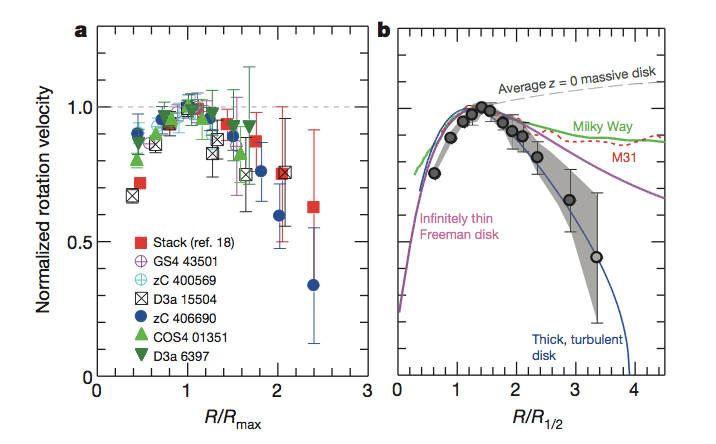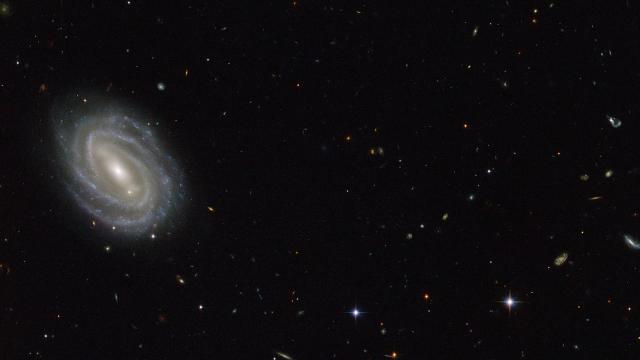There’s a gravitational anomaly that permeates our entire universe: The way most galaxies and clusters of galaxies behave implies that there’s around six times more matter than we actually observe. Scientists called the missing stuff that should create the unaccounted-for gravity we measure “dark matter”.
Image: ESA/Hubble & NASA, Acknowledgement: Judy Schmidt
Scientist Vera Rubin noticed one of the strangest anomalies back in 1976. Stars move faster further away from the centre of galaxies, but Isaac Newton’s laws say that once you get to the galaxy’s edges, where there’s a lot less observable stuff, the remaining stars and gas should move more slowly. Instead, Rubin observed the matter at the visible edges of galaxies spun at similar speeds to, or faster than, the stuff closer to the middle. This implied there was more matter (and more gravity) beyond what she saw, caused by something none of our experiments can observe.
But a new set of observations show that some incredibly distant, and therefore very young (but ancient, like a fossil) galaxies seem to behave differently than the ones Rubin and others have observed. This doesn’t disprove the so-called “dark matter” gravitational anomaly we see today. It does imply that certain early galaxies are way different from the ones we observe nearby. This could clue us in to how young galaxies transformed into ones like ours, and the role dark matter played in this transformation.
“There are some issues we need to think about,” Reinhard Genzel, astrophysicist at the Max Planck Institute for Extraterrestrial Physics told Gizmodo. “We feel that this shows pretty convincingly that dark matter is not as high a fraction of mass in the outer parts of these [galaxy’s] disks as they are in the local universe”, which includes galaxies close enough that the expansion of space hasn’t stretched out their light waves to cause a notable shift in their colour. A measly 10 thousand light years away, our own Milky Way’s borders seem to be completely dominated by dark matter’s effects. “That’s not what we see in these galaxies.”
These galaxies are on the order of billions to tens of billions of light years away.
Genzel’s team’s observations come from looking at specific kind of infrared light coming off of hydrogen atoms whose electrons lose a little bit of energy, using instruments on the Very Large Telescope in the Northern Chilean desert. They had to look at a selection of galaxies for several months to collect all of the very faint light needed to do their analyses, much of which was published in the journal Nature today.
Even taking into account any potentially confounding factors, like gas between Earth and the stuff they were observing interfering with the data, the scientists concluded these distant galaxies didn’t behave like the galaxies in our cosmic neighbourhood. They illustrated this with maybe the easiest-to-understand physics graph you will ever see, below: As you get to larger distances from the centre of a galaxy, from left to right in the graph, the velocity of matter increases, then drops off in all six of the galaxies on the lefthand graph — these are the distant galaxies. The data on these galaxies’ velocity curves are averaged into the grey area on the righthand graph, different from the our own Milky Way, our neighbour Andromeda (also known as M31), or average nearby galaxies, where the speed of matter either doesn’t drop off or increases further from the centre.

(Image: Genzel et al.)
This doesn’t mean we’ve disproved dark matter, by any means. Instead, we might be looking at the way baby galaxies make their stars. “This paper is not about dark matter,” Anže Slosar, who leads his futile existence as a scientist and a bureaucrat at Brookhaven National Labs, told Gizmodo. Instead, the scientists have observed that this set of distant galaxies are mostly dominated by ordinary gas instead of dark matter, with more turbulence causing the gas to slow down and possibly fall into the galaxy’s centre. “This is consistent with early universe where you have lots of molecular gas, fuel for stars lying around and it can… produce violent star formation.” He said we still need a halo-shaped skeleton made from dark matter to begin with, but that there’s so much gas in these early galaxies that the behaviour of the gas dominates our observations.
Reinhard agreed. “In our Milky Way, interstellar gas is eight to ten per cent. At high redshift,” meaning incredibly far away, “some of these galaxies have 70 per cent gas. With that much gas you can form stars very quickly.”
But Genzel also noted that theories of dark matter as we’d like to think it exists, in the form of particles, aren’t having a good time right now. Searches for some sort of particle that could explain the dark matter gravitational anomaly have mostly turned up empty handed, and scientists will soon look for more exotic dark matter options. “There are a number of people speculating that perhaps we are on the wrong track as far as the nature of dark matter is concerned,” he said. “Maybe it’s not a particle.” Genzel is personally less interested in what his findings may or may not say about dark matter and more excited about new insights into galaxy formation. But “in any case these more speculative possibilities should be explored”.
Scientists need to be cautious before making statements about the nature of these distant galaxies, though. “An important caveat is that this is not true for all galaxies at that redshift, but for this particular subset of galaxies. They chose [to study] these, because they are comparably easy to observe,” said Slosar.
Genzel agreed — he’s quite familiar with the way science works. “I should say it will take a while until other people will be able to check this,” he said. “As you know it’s essential in science: Just because we say it doesn’t mean it’s true.”
[Nature]
